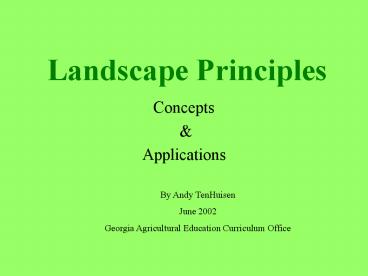Landscape Principles - PowerPoint PPT Presentation
1 / 65
Title:
Landscape Principles
Description:
No scalloped bed lines; gentle curves. Repetition. Mass Plantings. Repetition ... Principles should be followed to create a sense a beauty ... – PowerPoint PPT presentation
Number of Views:70
Avg rating:3.0/5.0
Title: Landscape Principles
1
Landscape Principles
- Concepts
- Applications
By Andy TenHuisen June 2002 Georgia Agricultural
Education Curriculum Office
2
Objectives
- To identify the principles of art as it pertains
to landscape design - To distinguish between good and poor landscape
designs - To explain the importance of implementing design
principles - To describe methods of obtaining design principles
3
You know when something looks good, but can you
explain to someone else why you like it?
4
Which do you like?
- Why do you like that one?
- What makes it different from the other?
- Does this relate anything at all to a haircut?
5
Why dont you like this house?
- How do you tell another person why you dislike
this house? - Can you put into words what needs to be done to
improve this houses curb appeal?
6
Lets take a look and find out what words you can
use to better describe what you like
7
Balance
- Means equilibrium
- Visual weight of the landscape is equal
- Unbalanced objects cause the viewer to be uneasy
and confused - Two types of balance can be used in the landscape
8
Symmetrical Balance
- Mirror image
- Used more for formal architecture
- Visual weight is balanced
9
Which house has symmetrical balance?
10
Asymmetrical Balance
- Visual weight is balanced but not mirror images
- Used more in informal architecture
11
Home landscapes lacking balance are unappealing
12
Simplicity
- Should be soothing to the eye not busy
- No competing objects
- Minimal plant variety
- No scalloped bed lines gentle curves
- Repetition
- Mass Plantings
13
Repetition
- Repeating shapes helps maintain simplicity
14
Mass Plantings
- Large beds of one plant variety achieve simplicity
15
Simple Design
- Using minimal plant variety
- Gentle curving bed lines
- Repetition
16
What characteristics of simplicity are achieved
here?
- Curved bed lines
- Minimal plant variety
- No competing objects
- Not busy
17
Focalization
- Visual importance
- One item appears to dominate
- Dont have competing focal points
- Draws attention
18
Front Door
- The front door should be the focal point of the
landscape
19
Accenting the Front Door
- Using brass kick plate
- Use lights and lighting fixtures
- Sidewalks lead eye to door
- Using porticos
- Stained glass
- Vertical elements
- Small flower beds
20
Front Doors
21
Wheres the front door?
22
Rhythm Line
- What is rhythm?
- How to achieve rhythm?
- What lines are we concerned with?
- Sequencing?
23
Rhythm
- Landscapes have rhythm just as music has rhythm
- Music has a beat (count)
- Music has repetition of notes in the same scale
- Landscapes have rhythm by a repetitious count of
textures/form/color
24
Rhythm
- Repeating plant form/color/texture throughout the
entire landscape
25
Rhythm
- Tying areas together
- Continuity
- Gradual changes
26
Line
- What the eye follows
- Everything has a line
- Tree outlines
- Bed lines
- Patios Decks
- Buildings
- Gradual changes of line are most appealing
27
Lines
28
Bed lines
29
Vertical Lines
- Vertical lines draw attention
- Create a sense of tension and nervousness
- Tend to exaggerate
30
Horizontal Lines
- Horizontal lines create a sense of warmth and
tranquility - Do not draw attention
31
Sequencing
- Positioning objects according to size
- Small medium large
- Provide a smoother line for the eye to follow
- Provide views of all plants
- Help create horizontal lines
32
Sequencing
33
Lacking Rhythm Line
34
Scale Proportion
- Large objects dwarf other objects
- Large objects tend to be overpowering and cause
uneasiness - Large objects used with large structures create
proportion
- Small objects create a feeling of warmth and
serenity - Small objects enhance or exaggerate other objects
- Dwarfed plants should be used with smaller
landscapes
35
Proportionately Correct
36
Incorrect Scale
37
Large plants in front of house help dwarf the
house
38
Review of Principles
- Balance
- Simplicity
- Focalization
- Rhythm Line
- Scale Proportion
39
Symmetrical Balance
40
Asymmetrical Balance
41
Unbalanced
42
Simplicity
- Gentle curves and lines
- Repetition of plants
- Mass plantings
43
Simplicity
- One focal point
- Same texture
- Horizontal lines
44
No Simplicity
45
Focalization
- One focal point
- No competing elements
- Vertical lines help draw attention
- Changes in form
46
Rhythm Line
- Bed lines tie areas together
- Horizontal lines create a feeling of warmth
- Repetition provides continuity
- Simplistic designs create rhythm
47
Scale Proportion
- Using plants in size relationship to complement
rather than offend - Larger plants are overpowering and create
uneasiness - Smaller plants generate warmth
48
Lets take a look at some more desirable
landscapes
49
(No Transcript)
50
(No Transcript)
51
(No Transcript)
52
(No Transcript)
53
(No Transcript)
54
(No Transcript)
55
(No Transcript)
56
(No Transcript)
57
Lets take a look at some designs lacking good
landscaping principles
58
(No Transcript)
59
(No Transcript)
60
(No Transcript)
61
(No Transcript)
62
(No Transcript)
63
(No Transcript)
64
Conclusion
- Remember landscaping is an art
- Principles should be followed to create a sense a
beauty - The most exquisite landscapes generally are the
most simplistic in design - The brain imports information from senses. Dont
overwhelm the brain with excessive visual inputs!
65
The End!































